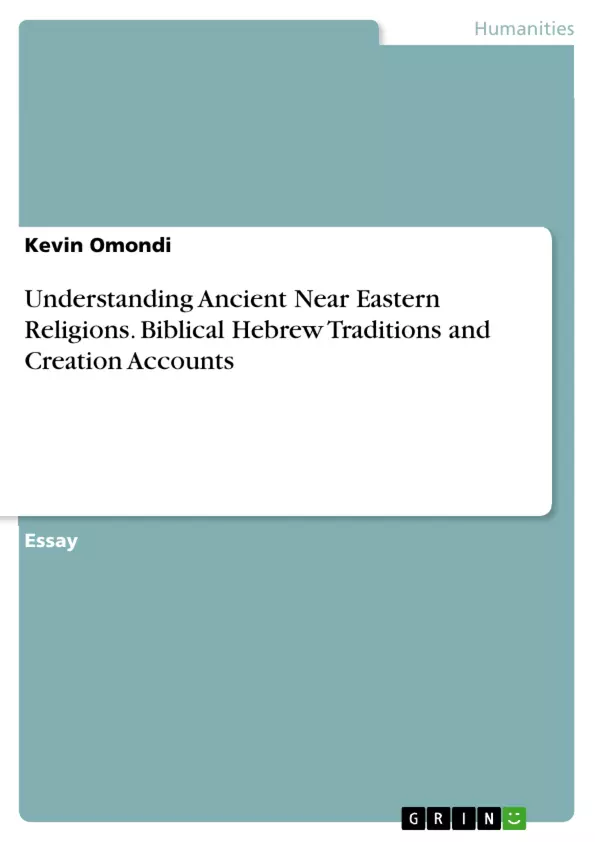This text aims to provide an insightful examination of the relationship between Ancient Near Eastern religions and Biblical Hebrew traditions, highlighting their similarities and distinctions, particularly in the context of creation accounts.
The Biblical world, in which persons and traditions are documented in the Hebrew Bible, dates from the third millennium B.C.E through the intertestamental period in Jewish literature. If Apocrypha and Pseudepigrapha are to be included, the Hebrew Bible settings must finish with Persian history. The setting of the Ancient Near East, Mediterranean, and North Africa served as a historical, social, and theological backdrop from which Biblical traditions and literature arose. This paper endeavors to address presumptions related to the ancient Near East, focusing on God and man; the assessment of Ancient Near Eastern religion found in the Hebrew scriptures, by analyzing some of the important traditions, rituals, and beliefs held by those communities; and the critical points of difference between Ancient Near Eastern and Biblical Hebrew when looking at the creation accounts.
Inhaltsverzeichnis (Table of Contents)
- Ancient Religion
- Bodies of God and the Environment of Ancient Israel
- Divine Fluidity and Physical Bodies
- Temples and Earthly Dwellings as Platforms of Divine Residency
- The Divine Substitution and Human Self
- Ancient Near Eastern Religion in the Hebrew Scriptures
- Similarities in Traditions and Rituals
- Deities and the Concept of God
- Temples and Rituals in Ancient Near Eastern and Hebrew Cultures
- Divination and the Heavenly Realm
- Distinctive Features of Ancient Near Eastern and Biblical Hebrew
- Theogony and Creation Narratives
- Cosmogony and the Creation of the World
- The Moral Personality of Deities
- The Concept of Human Self-Evolution
Zielsetzung und Themenschwerpunkte (Objectives and Key Themes)
This paper aims to explore the ancient Near Eastern religious landscape and its influence on the development of Biblical traditions and literature. It investigates the concept of God and humanity in the ancient Near East, analyzes key traditions, rituals, and beliefs of these communities, and examines significant points of difference between Ancient Near Eastern and Biblical Hebrew perspectives on creation.
- The Nature of Deity in the Ancient Near East
- Similarities and Differences between Ancient Near Eastern and Biblical Hebrew Religious Practices
- The Role of Temples and Rituals in Both Cultures
- The Influence of Ancient Near Eastern Religions on the Formation of Biblical Traditions
- The Uniqueness of the Biblical Creation Narrative
Zusammenfassung der Kapitel (Chapter Summaries)
- Ancient Religion: This section provides an overview of the historical and theological context of the ancient Near East, highlighting the key features of the region's religious practices.
- Bodies of God and the Environment of Ancient Israel: This chapter explores the concept of divine fluidity and the belief that deities could inhabit physical objects, including temples, statues, and images. It also examines the role of temples and earthly dwellings as spaces of divine residence in antiquity.
- Ancient Near Eastern Religion in the Hebrew Scriptures: This chapter analyzes similarities and differences between the religious practices of ancient Near Eastern cultures and those of the Israelites. It examines the shared traditions, rituals, and beliefs, as well as the unique features of Israelite monotheism.
- Distinctive Features of Ancient Near Eastern and Biblical Hebrew: This chapter focuses on key differences between the two religious systems, including their views on theogony, cosmogony, the moral personality of deities, and the concept of human self-evolution.
Schlüsselwörter (Keywords)
Ancient Near Eastern religion, Hebrew Scriptures, creation narratives, deities, temples, rituals, traditions, monotheism, polytheism, divine fluidity, human self-evolution, creation ex nihilo, theogony, cosmogony, Genesis, Old Testament, Mesopotamia, Egypt, Babylonians, Assyrians, Persians.
- Quote paper
- Kevin Omondi (Author), 2023, Understanding Ancient Near Eastern Religions. Biblical Hebrew Traditions and Creation Accounts, Munich, GRIN Verlag, https://www.grin.com/document/1401100




